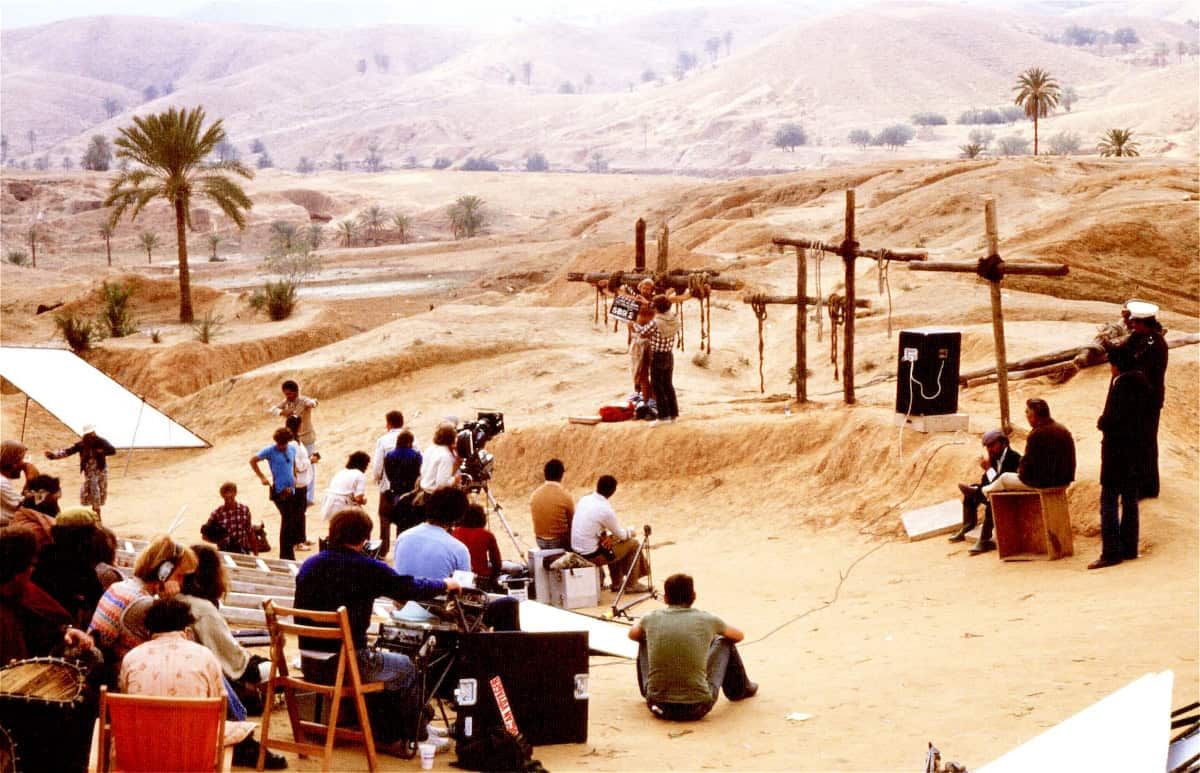By Julian Doyle
In the early ’70s, I’d worked with the Pythons on a few spoof commercials. From that association,. Terry Jones came to me with a script for Monty Python and the Holy Grail, which he would be directing and wanted me to handle effects photography.
It had a few medieval scenes and a couple of scenes in Harrods wig department, and they and asked me to budget it. “Sure thing,” I said. “We could do it for £200,000.” But then they only managed to raise £164,000 from Pink Floyd, Led Zeppelin, and Island Records.
I still felt we could do it … till they showed me the final script. I sat at my desk reading it and laughing and groaning at the same time. It was very, very funny but there were NO scenes in Harrod’s wig department anymore, it was all medieval! And they wanted to shoot the whole thing in Scotland!
Luckily, the horses were ruled out and we used coconuts, but the budget was still too small. After six weeks of hell in Scotland trying to shoot it for the budget, we returned to London missing many shots and even whole scenes. Terry Gilliam could cover one missing scene with animation and I would shoot the invincible Black Knight, just outside London, in Epping Forest. John Cleese played the Black Knight up to his arms coming off. Then we got a tall one-legged man to shoot the first leg off. And here we puppeteered the last leg off.
Those were the days before computers. I shot the opening scene of the film in a London park, where I also arrested Lancelot (played by John Cleese) — we had so little money for extras that I also played the policeman who brings the film to an end. And the film crew appeared throughout the film, including as the French soldiers surrounding John Cleese as he taunted King Arthur.
As they did not have enough money to pay for all I did, I was given a percentage in the film and even though the film went over budget by £40,000 it went on to make a huge profit, as did my bank balance.
When Terry Jones asked me to do the same on Life of Brian, I said it was too much work but so he said I must do something. So I said I would edit it. Little did I know it was not going to end there.
In fact, that film has indirectly led to the most amazing 45 years of fun since its release, sending me off on a search to unravel the history of the last 2,000 years concerning the life and times of the historical Jesus.

It all began when I was sat on the sand in Tunisia during the location work for Life of Brian. I was watching the crucifixion scene being filmed — the one that famously ends with Eric Idle singing Always Look on the Bright Side of Life — when I realised that something was seriously wrong with the process (crucifixion, I mean, not Eric’s dulcet tones). It just didn’t make sense, logically, as a method of execution.
Investigating the historical basis for believing Jesus was crucified was just the start. I can’t catalogue in a few paragraphs all I’ve discovered, which has taken me more than 300 pages in my new book, The After-Life of Brian, to set down, but in short that research has unravelled everything from the first century Jesus story to the 12th century Knights Templar, to being able to understand John Cocteau’s celebrated if inscrutable movie Orphée and everything in between.
But I’d be a spoilsport if I didn’t at least give you a taste of the huge fun I’ve had, so let’s look to unravel a rather famous and enigmatic painting by Leonardo Da Vinci: Saint John the Baptist.
This, would you believe, is a painting by Leonardo of John the Baptist. If you were not told, there is no way you would think it was John with that weird, knowing smile. Do you believe what the National Gallery says about the finger? “The finger pointing to heaven, alludes to Christ’s future destiny.”
Surely not! With that knowing grin he is supposed to be thinking of Jesus’ death and resurrection? Come on, this clearly has absolutely nothing to do with Christ’s passion. Leonardo is clearly trying to tell us something. Remember, some experts have claimed that Leonardo was a Rosicrucian (the Rosicrucians were an early spiritual movement) or at least had, what they call, Rosicrucian beliefs.
Now look at Leonardo’s Burlington House cartoon with Jesus and John the Baptist. Do you see the finger again? These are not the only Leonardo/Baptist paintings with the pointing finger.
To unravel this, we need to look at a collection of documents deposited anonymously in the Bibliothèque Nationale in Paris during the 1960s. They contain rather odd but accurate information about French history concerning the heretical Church at Rennes-le-Château and certain underground organisations including the Templars.
All were written under pseudonyms or attributed to people later found to be deceased and who had nothing to do with them. One of the authors was finally discovered to be French writer Philippe de Chéresey and was said by him to be a sort of surrealist joke to create a supposedly ancient organization called the Priory of Sion. This Priory of Sion, in fact was not ancient as it was first registered in 1956. So now the whole event is taken as a hoax.
The problem is that some of the information is so obscure yet so accurate that it would take years of research to discover – just for a joke? I am not saying Philippe de Chéresey’s dossiers were not a hoax, I am saying that they had a source of information not available to the academic world, and they used it to give credence to their so-called ‘joke’.
The dossiers list an unbelievable list of Grand Masters from a splinter group of the Knights Templar. I cannot tell you if it is real, but I cannot quite believe anyone could write a list of 26 people — which starts in 1188 and stretches to recent times, and which links known and little-known people whose interconnections actually are not obvious — without a great deal of research. It would be a massive undertaking just for a gag.
Still with me? OK, it is said the people in the list were not called ‘Grand Masters’ but ‘Nautonniers’, which is French for ‘Navigators’. So here is the extraordinary, or perhaps ridiculous, list of Nautonniers.
Jean de Gisors (1188–1220); Marie de Saint-Clair (1220–1266); Guillaume de Gisors (1266–1307); Edouard de Bar (1307–1336); Jeanne de Bar (1336–1351); Jean de Saint-Clair (1351–1366); Blanche d’Évreux (1366–1398); Nicolas Flamel (1398–1418); René d’Anjou (1418–1480); Iolande de Bar (1480–1483); Sandro Botticelli (1483–1510); Leonardo da Vinci (1510–1519); Connétable de Bourbon (1519–1527); Ferrante I Gonzaga (1527–1575); Ludovico Gonzaga (1575–1595); Robert Fludd (1595–1637); J. Valentin Andrea (1637–1654); Robert Boyle (1654–1691); Isaac Newton (1691–1727); Charles Radclyffe (1727–1746); Charles de Lorraine (1746–1780); Maximilian de Lorraine (1780–1801); Charles Nodier (1801–1844); Victor Hugo (1844–1885); Claude Debussy (1885–1918); Jean Cocteau (1918–1963).
In 1629, Robert Denyau, curé of Gisors, composed a history of the Gisors family, the Histoire polytique de Gisors et du pays de Vulcsain. This manuscript, now in the Bibliotèque de Rouen, states that the Rose-Croix (i.e., the Rosicrucian order) was founded by the first person on the list above, Jean de Gisors. So this suggests the list is a list of members of l’Ordre de la Rose-Croix Veritas, not the Priory of Sion.
Anyway true or fake, these Chiefs all take on the name: John and a number (John XXI is followed by John XXII and so on). Now what’s interesting is that the first, Jean de Gisors, is John II. The writers of international bestseller The Holy Blood and the Holy Grail, who first published the list, were unsure which historical John was John I, but they suspected it was John the Baptist.

If that’s right then perhaps this explains the raised index finger of John in the portrait by Leonardo. It’s raised to tell us exactly who was number one. Still don’t believe me? Look again at the painting of the Baptist above. The right-hand index finger indicates one, but look who his other hand is pointing to. His left hand points to himself! There can be no doubt that the Baptist is telling us, “I am number one”.
Interestingly, this makes Leonardo da Vinci, also on the list, John XIII so we can understand his John paintings
This is, of course, only one small part of a much bigger picture which spans time and geography. I hope you have enjoyed this little glimpse into the giant jigsaw puzzle I’ve been working on all these years, between, you know, making films.
If you want all the pieces so you can form your own conclusions, feel free to pick up a copy of my book. It’s anything but spam, spam, spam, I promise, though don’t be surprised if you receive a call from the Spanish Inquisition for being a naughty boy just like I’ve been!
The After-Life of Brian by Julian Doyle is out now on Amazon, priced £34.79 in hardcover and £5.79 as an eBook. For more information, visit www.juliandoyle.info

